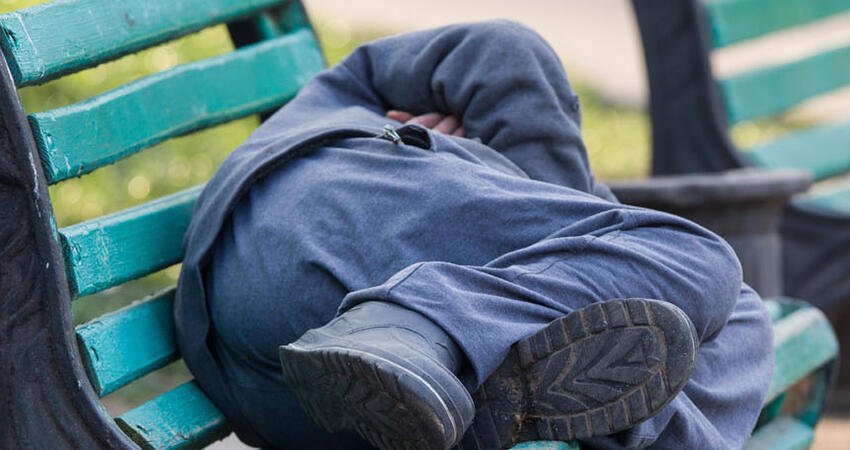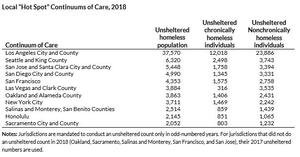
What Fueled the Increase in Unsheltered Homelessness in 2018?
by Aaron Shroyer
In 2018, over half a million people experienced homelessness on a given night in the US. Of those, roughly one in three experienced unsheltered homelessness in a car, outside, or in other places not meant for human habitation.
Over 90 percent of people experience unsheltered homelessness as individuals, meaning they do not have a child with them. Many of these individuals are also considered chronically homeless, which the US Department of Housing and Urban Development (HUD) defines as an unaccompanied homeless person with a disabling condition who has either been continuously homeless for a year or more or has had at least four episodes of homelessness in the past three years.
Despite some year-to-year spikes, the chronically homeless portion of the unsheltered population has stayed roughly the same since 2013, but the number of nonchronically homeless unsheltered individuals increased 11 percent over the same five-year period, including a 23 percent increase since 2015.
Geographic Trends in Unsheltered Homelessness
A few geographies drive increases in unsheltered homelessness. In 2018, approximately 40 percent of all people experiencing unsheltered homelessness nationwide resided in 11 Continuums of Care (CoCs), the geographic classification HUD uses to allocate funds under the largest homelessness-specific grant program. These jurisdictions have driven significant growth in both unsheltered chronically and nonchronically homeless populations. From 2015 to 2018, the population of unsheltered chronically homeless individuals increased by 4,665 in these 11 CoCs. Nationally, the population of unsheltered chronically homeless individuals only went up by 3,071, meaning the number of unsheltered chronically homeless individuals decreased nationally except for these 11 CoCs. From 2015 to 2018, these 11 CoCs added 12,758 unsheltered nonchronically homeless individuals, which made up over half of the national growth over that time.
This spike in the number of unsheltered nonchronically homeless individuals may indicate that many were experiencing homelessness for the first time. Not coincidentally, these jurisdictions also have low vacancy rates and few available units for those at or below the extremely low–income threshold.
These hot spot CoCs have a severe shortage of affordable housing for those with extremely or very low incomes. These CoCs account for approximately one-fifth of the national shortage of available and affordable units for extremely low-income households. As a result of this shortage, many extremely low–income households are forced to pay over half of their income on rent (referred to as severely cost-burdened renters). In some metropolitan areas like Las Vegas, 86 percent of extremely low–income households pay over 50 percent of their income on rent. These rental payments crowd out spending on basic needs. In addition, high rent makes extremely low–income households vulnerable to other financial shocks, such as health emergencies. When these financial shocks arise, the inability to pay those costs plus rent could result in homelessness.
Solutions
To make homelessness rare, brief, and nonrecurring (PDF), cities should design policies that support low-income households at risk of becoming homeless and allow nonchronically homeless households to regain stable housing. More specifically, jurisdictions should invest in housing solutions and services and make shelter options more accessible for those experiencing unsheltered homelessness.
Nonchronically and chronically homeless individuals may require different interventions and service levels to get them into stable housing. Nonchronically homeless individuals experiencing homelessness for primarily financial reasons may need a housing voucher or other guaranteed rent subsidy. In addition to a permanent housing subsidy, chronically homeless individuals might also need support services, such as mental health or substance abuse counseling. Permanent supportive housing combines affordable housing with wraparound support services and is cost-effective when compared with the cost of staying in a shelter. However, many jurisdictions lack adequate permanent supportive housing units, creating a backlog in shelters. Jurisdictions must invest in permanent housing solutions to ensure that there is a flow-through between people entering shelters and people exiting to permanent supportive housing. Or better yet, permanent housing programs could allow entry directly from the streets through Housing First models.
To encourage people experiencing homelessness to go to shelters, shelters should have flexible operating policies that accommodate the needs and concerns of would-be residents. When shelters have strict entry requirements, they prevent people experiencing unsheltered homelessness from going into the system. These barriers include household configuration requirements, sobriety rules, rules against pets, and limited storage for belongings. By eliminating these deterrents, jurisdictions can help put people experiencing homelessness on a pathway toward stable housing.
Photo by Peyker/Shutterstock

